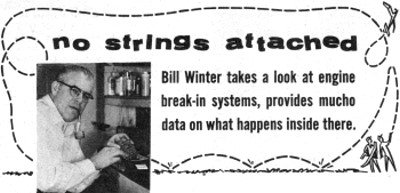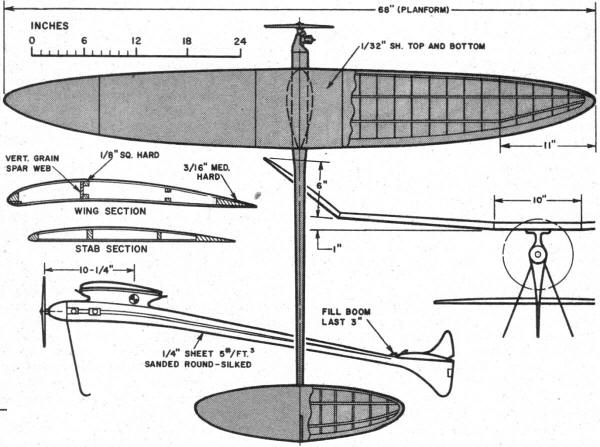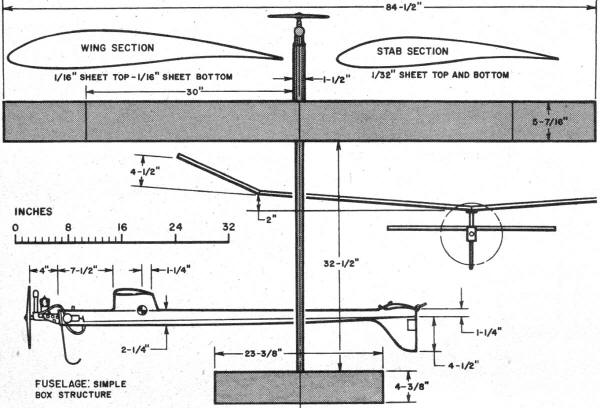|
Well-known
modeling editor Bill Winters waxes wonderingly about whether the
"theoretician" modelers who use "wind tunnels, slide rules, [and]
adding machines" might really be gaining an edge over the "rule-of-thumbers"
who pioneered the basic precepts of various model aircraft design
and operation through trial-and-error processes. By removing environmental
variables like wind, thermals, and terrain, he considers how recent
gains in indoor events have rewarded renowned "thinker" type modelers
with great advanced in record performances. No Strings Attached
By Bill Winter Bill Winter takes a look at engine
break-in systems, provides much data on what happens inside there.
 Should
you break in a new engine? Ask your modeling buddies and you'll
get answers ranging from yes by all means, through all shades of
maybe-sometimes to it's a waste of fuel. Should
you break in a new engine? Ask your modeling buddies and you'll
get answers ranging from yes by all means, through all shades of
maybe-sometimes to it's a waste of fuel. If these answers
baffle you, just don't ask the guys who say yes, how they go about
loosening up a scrawnchy mill. Merlin - would have been right at
home with his incantations, fiery circles and stuff. Can't
remember whether or not the Brown Junior required breaking in. The
prehistoric Junior apparently got awfully hot - but it kept running.
Fins became purple. We do know that from the late thirties until
after the war, when glow plugs and "shoe polish" fuels came on the
scene, engine breaking-in was de rigor, whatever that is.
It was nothing to clamp your new Bantam to a bench and let it
howl from dawn to dusk in the back yard. Neighbors - some of them
anyway - took kindly to ambitious young men who strode the path
of Lindbergh. (Today they call the gendarmes or the guys in white
coats.) Engine producers like Benny Shereshaw made their engines
so tight you had to run them for hours. Recall OK's post-war Mohawk
.29, which we turned over with a hand drill - the Merlin (not the
sorcerer this time) was another. We remember Keith Storey telling
us that the first team race put on in California was won by a Mohawk.
Further, our number-one boy fledgling flew the family Mohawk for
two years in Ukie and it hadn't begun to wear. Post-war the
arguments began. We suspect Half-A and small glow engines in general
had a lot to do with this for, as we know today, small engines seem
ready to give their all, whereas many big engines are prima donnas.
You've got to plead with them, like pushing the aft end of a mule.
(Hi Johnson tells us a good reason why, but more of this anon.)
Now the best Torps we ever had included the first two-speed
.19 - personally we loved the older Torpedo of the late forties
before everyone went rpm crazy - which Ted Martin ran 10 hours in
engine tests with all kinds of props, big and little, and at some
shattering rpm figures. That poor engine afterwards wore out three
Live Wires and was hotter than ever when some fool drove a station
wagon over the nose end of the last LW. The other hotter-than-hot
Torp was a .23 that one of the sprouts pilfered from our hope chest,
ran wide open new in Ukie stunt, leaned out, piled into the mud,
and so on. For 18 subsequent months that .23 struggled valiantly
with our seven-pound rudder job.

"Snicker": J.M. Trego's FAI Power. Wingspan,
68" (platform); 40-60 ellipse; Wing Root chord, 9"; Aspect ratio,
9"; Wing area, 445 sq. in.; Stab root chord, 6 1/2"; Stab area,
120 sq. in.; Wing incidence, four degrees; Stab incidence, 3 1/2
degrees; Center of Gravity, 70%; Wing airfoil, Goldberg G-610; Stab
airfoil, 6.8% at 30% (flat bottom).Of course,
we broke in many engines for hours on end. In the air they over-heated
and died. One of them had so much compression it wind-milled in
fast glides. The truth of the matter is that some modern
engines require no breaking in (and come to think of it, whoever
heard of breaking in an Arden; we turned 12-inch and cut-down 14-inch
props on a .19 on 90-degree days) and others will be ruined if not
run-in. Have had Webra Diesels, for example, that would freeze if
leaned out within four hours - but when they came-in they'd outlive
a turtle. Two buddies have Super Tiger R/C's on the block for six
hours and the engines are not yet ready to handle multi chores.
Our Frog .09 diesels were still picking up rpm after 11 hours of
flying! There was one glow .09 of ours that wore out the bearings
before it broke in enough to fly! And so it goes. Now that
we have everyone suitably confused, let's listen to a man who knows
what he is talking about (for a change!). So many club papers have
picked up Hi Johnson's tips on breaking in engines that, on the
theory where there is smoke there must be fire, we consider now
the august pronouncements of one engine man. (If it turns out that
engine makers, like modelers, also argue the issue, we no doubt
will come back in due time to the break-in discussion.)

"Mozagotl": Werner Petri's 1960 FAI Power.
Wingspan 84 1/2"; Overall length, 53"; Wing area, 461 sq. in.; Aspect
ratio, 15.5; Stab area, 102 sq. in.; Wing incidence, zero; Down
thrust, minus 3 degrees; Side thrust, 1 degree; Stab incidence (power),
minus 2 degrees; Stab incidence (glide), minus 4 degrees; Center
of Gravity, 77%; Power, reworked Super Tiger G-20 (1959) with intake
extension (kadency effect). Auto-rudder and auto-stab trim operated
by single mechanical timer, auto-stab operated by bell-crank on
T.E. Machined dural engine mount with four synthetic rubber grommets
for vibration isolation.Having read Hi's very
useful data umpty-ump times we have learned something new, proving
that you can teach an old dawg new tricks. To boil it down, Hi describes
a kind of molecular stampede in the metal as it is machined, worked,
and treated during the manufacturing of an engine. (Incidentally,
some guy on the side lines tells us that it is always "engine",
and never "motor", because motors are electric). Manufacturing
processes, it appears, introduce stresses in the materials and the
mischievous molecules remain partially unstable after that, no matter
what. The crux of the matter is that the number of cycles of heating
and cooling that an engine must pass through to attain molecular
stability depends entirely on the molecular state of the metals
at the time of engine purchase. Having had two new .15's freeze
in the air, tossing expensive nylon props, and washers, into the
weeds - new sleeves and pistons coming up! - we'd say this molecular
state sometimes borders on anarchy. Anyway, the word is that
it's the first four or five minutes of running time (each time)
that counts, and not a three- or four-hour break-in run that only
frees the engine slightly. According to the Johnson Doctrine, many
short runs, never leaning out, allowing the engine to heat up and
cool off completely, bring law and order to the delinquent molecules.
The bigger the engine, the more the naughty molecules. And that
is why Half-A engines take little or no break-in time. Shucks, we
always thought the Half-A engine makers were more ingenious!
How about break-in fuel? Use a mild fuel (less than 12 per cent
nitro) for the first hour or two - on .15's and up, decrees Mr.
Johnson. For small engines, use the fuel marked "For Half-A" on
the can. Adjust the needle to medium rich (medium rpm four-cycle),
run off a five to seven-ounce tank. Repeat as many times as necessary
for at least 30 minutes running time. To this we add, don't overload
the engine with a big prop during break-in. Is "Theory"
Vindicated? Probably you, too, have noticed the growing
respect for "long hair" designers. Like breaking in engines, the
merits of theory as opposed to the rule-of-thumb school of design
has always been good for a rainy day argument. For many years the
American approach leaned toward rule-of-thumb. A lot can be said
for it. In the beginning, pioneers endlessly ground out models,
gradually changing this and that until they knew all the basic answers
on proportions, areas, dihedral, and so on. Some became authorities
- justly we think - by evolving formulas to express what they already
knew, so that others could apply the hard-won knowledge.
In the middle years, when modeling attained truly popular acceptance,
anybody who built a few jobs that flew fairly well could consider
himself a theoretician. To the rest of us some of these talkative
chaps were a pain in the neck. By reaction we became a bunch of
rule-of-thumbers. Oh, there were guys who thought, witness Goldberg
and the pylon gassie, but this was still a common-sense, though
impressively reasoned approach. That is, it didn't require wind
tunnels, slide rules, or adding machines.
Perhaps
we began to have nagging doubts about our instinctive disapproval
of "theory" when, in Europe men like Czepa, Hacklinger, Benedek,
Van Hattum, Lindner, Samaan, largely through Nordics, displayed
results that at least proved a man could be deeply theoretical and
a top flier at the same time. So effective was their approach that
until Gerry Ritz came along the U.S. had practically conceded it
could never match the Continentals in some areas. A rule-of-thumber
himself, ole Zeke, has got to concede the theory boys - the authentic
ones, not just every guy who decides to go into the theory business
for himself - must really have an edge. This superiority is hard
to evaluate because natural things - such as thermals and time limits
- don't exactly encourage, or maybe even justify, all-out theory.
But what has set us to thinking, is this achievement of Hacklinger's,
a 44-minute flight in indoors. Don't spoil it by telling
us the flying site was super, but it seems to us that when a deep
thinker like Hacklinger, who long has held wide respect, on relatively
short notice (indoor is practically new in Europe) comes up with
a performance like this, he has demonstrated that "model engineering"
is equated with efficiency. Though all designs that can max
interminably seem the same, we shall suspect from here on in, that
one must always be better than all the others. It is nice to have
the best. Back to the drawing board!
Posted June 8, 2013
|